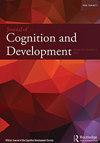Naïve迷信理论的发展
IF 2.1
2区 心理学
Q3 PSYCHOLOGY, DEVELOPMENTAL
引用次数: 0
摘要
摘要迷信行为跨越时间、文化和年龄而持续存在。虽然迷信通常被认为是非理性的,甚至有潜在的危害,但最近的研究表明,迷信对压力水平、自信,最终对表现有积极的影响。然而,目前还不清楚人们是如何理解迷信行为的,具体来说,人们是将迷信的明显功效归因于神奇的力量,还是其他原因,比如减轻压力或增加信心。在两项研究中,我们要求来自美国的6到9岁的儿童和成人评估迷信行为与预期结果的因果关系。在研究1中,参与者对探究为什么他们认为行为与结果相关的问题提供了开放式的回答。不同年龄段的参与者更有可能给出自然的解释,而不是神奇的解释来解释这种联系——随着年龄的增长,这一点变得更加明显。在研究2中,一半的故事不允许一个合理的自然解释,因此任何可感知的因果关系只能归因于魔法。参与者被问及迷信行为与结果之间的联系。我们发现,仅在我们的成人样本中,包含合理自然解释的故事和不包含合理自然解释的故事在连通性评分上存在显著差异。我们的研究结果表明,人们在推理迷信行为的功效时招募了他们的天真心理;然而,孩子们也可能相信魔法是有因果关系的。关键词:迷信、解释、理性心理学、魔法、因果关系确认数据收集在德克萨斯大学奥斯汀分校进行。我们感谢参与的孩子们,他们的父母,儿童研究中心的工作人员,以及以下帮助数据收集、编码、录入和可靠性的本科生:Ruth Esther Apura, Silviya Bastola, Cameron Bates, Katherine Bos, Zachary Bricken, Emma Brunk, Ashlea Cooper, Amanda Cramer, Matthew Finch, Julia Fishkind, Avery Largent, Cloris Lu, Candice Ma, Ashley Missimo, Jacquelyn Olivarez, Ilerioluwa Olugboye, Claire Perkins, Fernanda Ramos, Muskan Shah, Madeline Young和Jasmine Xu。还要感谢Jenny Nisssel和想象与认知实验室的成员对手稿早期草稿的反馈。披露声明我们已经报告了所有的测量、条件和数据排除,以及我们如何确定我们的样本量。数据可用性声明支持本研究结果的数据和用于分析的代码在OSF上是公开的,网址是https://osf.io/8q3xn/。本文章由计算机程序翻译,如有差异,请以英文原文为准。
Development of a Naïve Theory of Superstition
ABSTRACTSuperstitious behaviors persist across time, culture, and age. Although often considered irrational and even potentially harmful, superstitions have recently been shown to have positive effects on stress levels, confidence, and ultimately, performance. However, it remains unclear how people conceive of superstitious behaviors, specifically, whether people attribute apparent superstitious efficacy to magical forces or to something else, such as reduced stress or increased confidence. In two studies we asked 6- to 9-year-old children and adults from the United States to rate how causally connected superstitious behaviors were to desired outcomes. In Study 1, participants provided open-ended responses to questions probing why they believed the actions were tied to the outcomes. Participants were more likely across ages to offer natural than magical explanations to explain the connection – this became more pronounced with age. In Study 2, half the stories did not permit a plausible natural explanation, thus any perceived causal relation could only be attributable to magic. Participants were asked how connected the superstitious behaviors were to the outcomes. We found significant differences in ratings of connectedness between stories that held plausible natural explanations and those that did not in our adult sample only. Our findings suggest that people recruit their naive psychology when reasoning about the efficacy of superstitious behaviors; however, children may also believe magic to be causally relevant.KEYWORDS: superstitionexplanationsnaive psychology magiccausality AcknowledgmentsData collection took place at the University of Texas at Austin. We thank the children who participated, their parents, the staff at the Children’s Research Center, and the following undergraduate students who helped with data collection, coding, entry, and reliability: Ruth Esther Apura, Silviya Bastola, Cameron Bates, Katherine Bos, Zachary Bricken, Emma Brunk, Ashlea Cooper, Amanda Cramer, Matthew Finch, Julia Fishkind, Avery Largent, Cloris Lu, Candice Ma, Ashley Missimo, Jacquelyn Olivarez, Ilerioluwa Olugboye, Claire Perkins, Fernanda Ramos, Muskan Shah, Madeline Young, and Jasmine Xu. Thanks are also due to Jenny Nisssel and members of the Imagination and Cognition lab for feedback on earlier drafts of the manuscript.Disclosure statementWe have reported all measures, conditions, and data exclusions, as well as how we have determined our sample sizes.Data availability statementThe data that support the findings of this study and the code used for analyses are openly available on OSF at https://osf.io/8q3xn/.
求助全文
通过发布文献求助,成功后即可免费获取论文全文。
去求助
来源期刊

Journal of Cognition and Development
Multiple-
CiteScore
4.00
自引率
0.00%
发文量
29
期刊介绍:
The Journal of Cognition and Development is the official journal of the Cognitive Development Society (CDS). Some CDS members are concerned with basic research or theory; others focus on policy issues and practical applications. The range of interests includes cognitive development during all stages of life, and we seek to understand ontogenetic processes in both humans and nonhumans. Finally, their interests encompass typical as well as atypical development, and we attempt to characterize both biological and cultural influences on cognitive change and continuity.
 求助内容:
求助内容: 应助结果提醒方式:
应助结果提醒方式:


